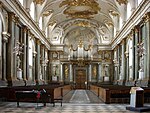Tessin Palace
Baroque palaces in SwedenOfficial residences in SwedenOfficial residences of Swedish county governorsPalaces in StockholmSwedish building and structure stubs

The Tessin Palace (Swedish: Tessinska palatset) is a baroque town house located in Gamla stan, the old town in central Stockholm. Located next to the Royal Palace, it is facing Slottsbacken, the major approach to the Stockholm Palace, and flanked by two alleys, Finska Kyrkogränd and Bollhusgränd. The mansion was constructed between 1694 and 1700 by architect Nicodemus Tessin the Younger. The building was inherited by Tessin's son Carl Gustaf Tessin who had to sell it in 1755 for financial reasons. The palace later became property of the crown and has been used as residence for the Governor of Stockholm and later Governor of Stockholm County.
Excerpt from the Wikipedia article Tessin Palace (License: CC BY-SA 3.0, Authors, Images).Tessin Palace
Bollhusgränd, Stockholm Gamla stan (Södermalms stadsdelsområde)
Geographical coordinates (GPS) Address External links Nearby Places Show on map
Geographical coordinates (GPS)
| Latitude | Longitude |
|---|---|
| N 59.325833333333 ° | E 18.073055555556 ° |
Address
Tessinska palatset
Bollhusgränd
111 31 Stockholm, Gamla stan (Södermalms stadsdelsområde)
Sweden
Open on Google Maps











